
Gas Works Park is a park located in Seattle, Washington, United States. It is a 19.1-acre (77,000 m2) public park on the site of the former Seattle Gas Light Company gasification plant, located on the north shore of Lake Union at the south end of the Wallingford neighborhood. The park was added to the National Register of Historic Places on January 2, 2013, over a decade after being nominated.

A gas holder or gasholder, also known as a gasometer, is a large container in which natural gas or town gas is stored near atmospheric pressure at ambient temperatures. The volume of the container follows the quantity of stored gas, with pressure coming from the weight of a movable cap. Typical volumes for large gas holders are about 50,000 cubic metres (1,800,000 cu ft), with 60 metres (200 ft) diameter structures.

The Gasometers in Vienna are four former gasholder houses, built as part of the Vienna municipal gas works Gaswerk Simmering in 1896–1899. They are located in the 11th district, Simmering. They were used from 1899 to 1984 to house gas holders, also known as gasometers, each of 90,000 m³ storage capacity. After the changeover from town gas to natural gas between 1969 and 1978, they were no longer used and were shut down. Only the brick exterior walls were preserved. The structures have found new residential and commercial use in modern times.

The Lena Water Tower is a water tower located in the village of Lena, Illinois, United States. It was built in 1896 following two decades of problems with structure fires in the village. The current water tower is the result of a second attempt after the first structure proved to be unstable. The tower stands 122.5 feet (37.3 m) tall and is built of limestone and red brick. The current stainless steel water tank holds 50,000 gallons and replaced the original wooden tank in 1984. The site has two other structures, an old power plant building and a 100,000 US gallon reservoir. The Lena Electric Plant Building was constructed in 1905 and the reservoir completed in 1907. The Lena Water Tower was listed on the U.S. National Register of Historic Places in 1997; the reservoir was included as a contributing property to the listing.

The Wheeler-Merriam House is a historic house located at 477 Virginia Road in Concord, Massachusetts. With a construction history dating to about 1692, it is one of Concord's oldest buildings. It is also notable for having joinery by Abner Wheeler, a prominent local builder of the late 18th century, and for its long association with the locally prominent Wheeler and Merriam families. It was added to the National Register of Historic Places on November 26, 1982.
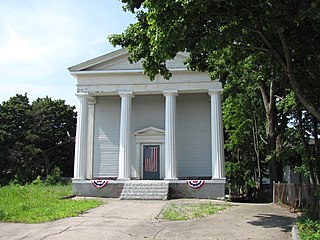
The East Attleborough Academy is an historic former school building at 28 Sanford Street in Attleboro, Massachusetts. Built in 1843, it is the town's only example of a Greek Revival temple front building. It originally served as a private academy, and has since served as the town's first high school, and as an office building. It is now home to the town's historical society. The building was listed on the National Register of Historic Places in 1985.
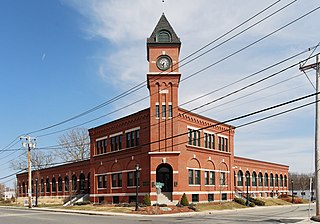
The H.F. Barrows Manufacturing Company Building, now the North Attleborough Police Station, is a historic industrial building in North Attleborough, Massachusetts. The elegant brick building was built in 1905–06, and was home for many years to one of the town's most successful jewelry businesses. It was listed on the National Register of Historic Places in 2001. Today the building serves as the headquarters for the North Attleborough Police Department.

The St Pancras Basin, also known as St Pancras Yacht Basin, is part of the Regent's Canal in the London Borough of Camden, England, slightly to the west of St Pancras Lock. Formerly known as the Midland Railway Basin, the canal basin is owned by Canal & River Trust, and since 1958 has been home to the St Pancras Cruising Club. The basin is affected by the large-scale developments in progress, related to King's Cross Central.

Lawson Tower is a historic tower built in the style of a European castle turret. It is located off First Parish Road in Scituate Center, Massachusetts, United States. Built in 1902 to enclose a steel water tank, it is a major local landmark. The Scituate Water Company stopped using the tank in 1988. The tower is listed as both an American Water Landmark and in the National Register of Historic Places. It has become a popular tourist site, featuring sweeping views of the South Shore, Old Scituate Light, Minot's Ledge Light and the nearby First Trinitarian Congregational Church.

The Old Faithful Historic District in Yellowstone National Park comprises the built-up portion of the Upper Geyser Basin surrounding the Old Faithful Inn and Old Faithful Geyser. It includes the Old Faithful Inn, designed by Robert Reamer and is itself a National Historic Landmark, the upper and lower Hamilton's Stores, the Old Faithful Lodge, designed by Gilbert Stanley Underwood, the Old Faithful Snow Lodge, and a variety of supporting buildings. The Old Faithful Historic District itself lies on the 140-mile Grand Loop Road Historic District.

The Quincy Electric Light and Power Company Station is a historic power station at 76 Field Street in Quincy, Massachusetts. Built in 1902, it is a well-preserved example of industrial Colonial Revival architecture executed in brick. It housed a coal-fired plant until 1920, and now serves as a local power substation. The building was listed on the National Register of Historic Places in 1989.
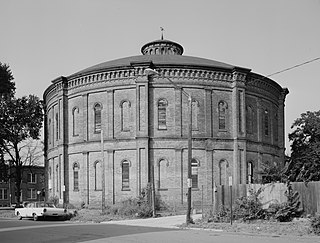
The Troy Gas Light Company was a gas lighting company in Troy, New York, United States. The Troy Gasholder Building is one of only ten or so remaining examples of a type of building that was common in Northeastern urban areas during the 19th century. It was designed by Frederick A. Sabbaton, a prominent gas engineer in New York State. Originally sheltering a telescoping iron storage tank for coal gas, the brick gasholder house is an imposing structure from a significant period in the history of Troy. For twenty-seven years the company held a monopoly on the manufacture of illuminating gas in the city.

Marcus Fayette Cummings was an American architect active in the Capital District region of the U.S. state of New York. Born in Utica, he later established his practice in the city of Troy, where many of his buildings are located in the Central Troy Historic District and listed on the National Register of Historic Places. Firm listed as Cummings & Brit in the Gazetteer and Business Directory of Rensselaer County, N. Y., for 1870-71. In 1891 he made his son, Frederick, a partner in the office, and promptly retired to Vineyard Haven, Massachusetts, on Martha's Vineyard. He maintained only a financial interest in the office of M. F. Cummings & Son, which would last into the 1930s.

The former Saratoga Gas, Electric Light and Power Company Complex is located near the northern boundary of Saratoga Springs, New York, United States. It is a seven-acre parcel with two brick buildings on it. In the 1880s it became the thriving resort city's first power station.

Georgetown Coal Gasification Plant, also known as the Georgetown Service and Gas Company, is a historic coal gasification plant located at Georgetown, Sussex County, Delaware. It was built in the late-19th century, and is a rectangular one-story, three bay by three bay brick structure measuring 40 feet by 25 feet. It has a gable roof with a smaller gable roofed ventilator. Also on the property is a small brick gable roofed brick building measuring 8 feet by 10 feet; a small, square concrete building; a large, cylindrical "surge tank;" 500-gallon bottled-gas tank; and a covered pit for impurities. The complex was privately owned and developed starting in the 1880s to provide metered gas for domestic lighting, town street lights, municipal and domestic uses. The coal gasification process was discontinued in the 1940s.

A gasholder house is a type of structure that was used to surround an iron gas holder, also known as a gasometer, in which coal gas was stored until it was needed. There are approximately a dozen of these structures—most constructed of brick in the latter-half of the 19th century—that still stand in the United States. Some examples still stand in Europe as well.

The Oval Gasholders is the unofficial name given to the gas holder (gasometer) located near The Oval cricket stadium in London, England. Construction began in 1853 and the site is officially called Kennington Holder Station by its owners, Southern Gas Network. It is a grade II listed building with the listed part of them known as Gasholder No. 1.
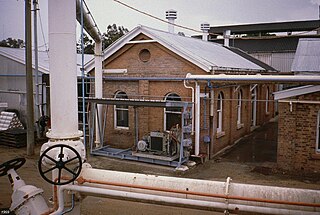
West End Gasworks is a heritage-listed gasworks at 321 Montague Road, West End, Queensland, Australia. It is also known as South Brisbane Gas and Light Company Works. It was added to the Queensland Heritage Register on 22 October 1999.
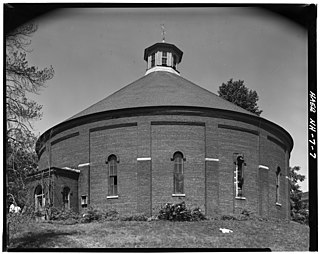
The Concord Gas Light Company Gasholder House is a historic gasholder house at Gas Street in Concord, New Hampshire. Built in 1888, it is believed to be the only such structure in the United States in which the enclosed gas containment unit is essentially intact. It was listed on the National Register of Historic Places in 2018. Since 2012, it has been owned by Liberty Utilities, a regional natural gas company, and its future is uncertain.
The Fitzroy Gasworks was a coal gasification plant in Fitzroy, Victoria. It is notable as the site for the first arc-welded gasholder in the world.






















